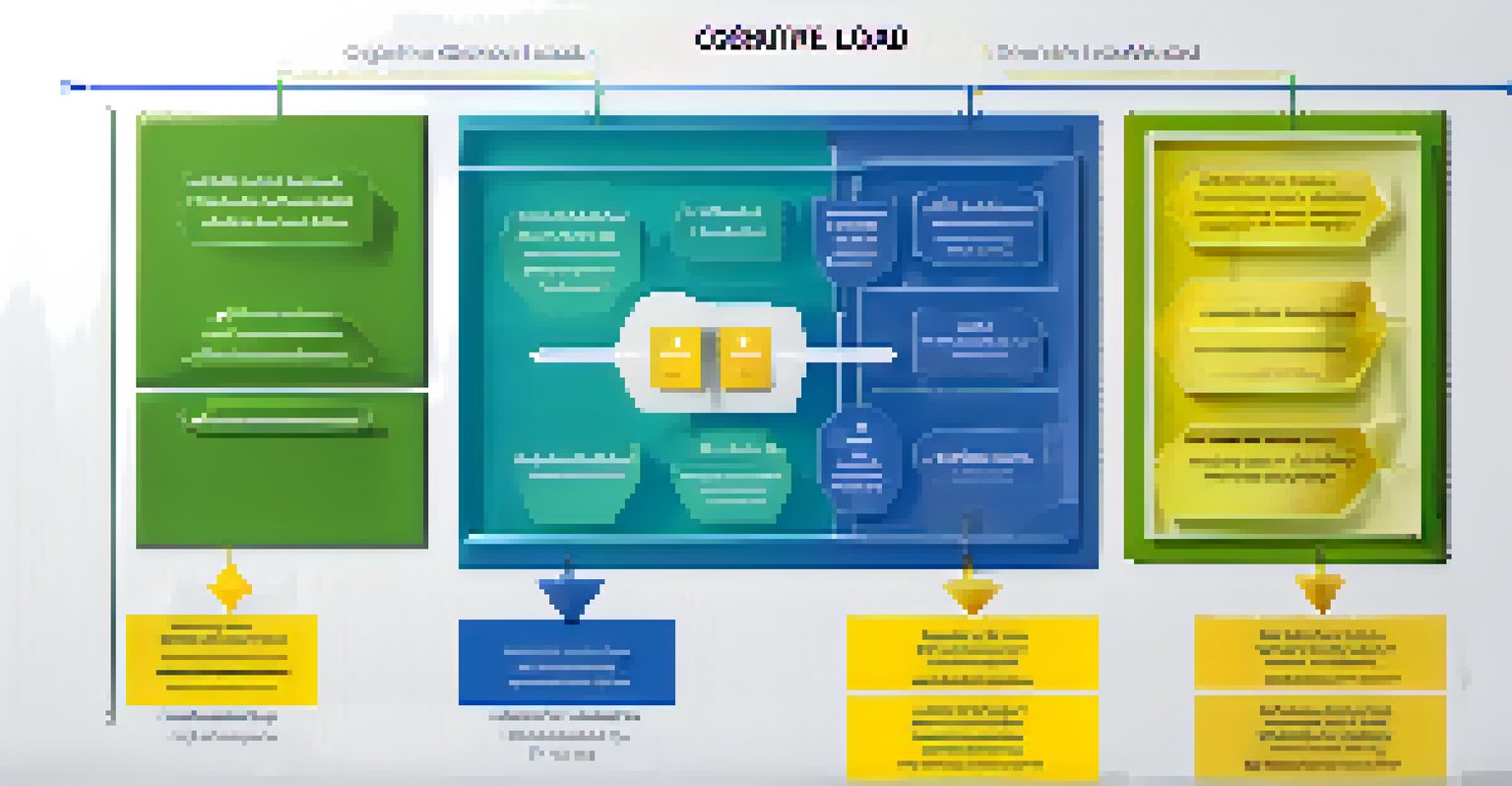Cognitive Load and Assessment: Designing Effective Tests

Understanding Cognitive Load: What It Is and Why It Matters
Cognitive load refers to the amount of mental effort being used in the working memory. When students are faced with assessments, their cognitive load can significantly influence their performance. If the load is too high, it can overwhelm learners, leading to confusion and poor outcomes.
The mind is not a vessel to be filled, but a fire to be kindled.
Imagine trying to juggle multiple balls while also solving a complex math problem. Just as the juggling diverts your attention, excessive cognitive load during a test can hinder a student's ability to focus on the questions at hand. Understanding this concept is crucial for educators aiming to design effective assessments.
By keeping cognitive load in check, we help students better retain information and effectively demonstrate their knowledge during evaluations. This is essential for creating an environment where learners can thrive.
Types of Cognitive Load: Intrinsic, Extraneous, and Germane
Cognitive load is generally categorized into three types: intrinsic, extraneous, and germane. Intrinsic load is the inherent difficulty of the material, while extraneous load involves distractions or unnecessary elements that complicate learning. Germane load, on the other hand, is the mental effort that contributes to learning and understanding.

For example, a complex math problem might have high intrinsic load, but if it's surrounded by irrelevant images or confusing instructions, the extraneous load increases, making it even harder to solve. Our goal as educators should be to minimize extraneous load while maximizing germane load.
Manage Cognitive Load for Success
Understanding and managing cognitive load is crucial for helping students perform better in assessments.
By recognizing these types of cognitive load, we can better structure our assessments to enhance learning and performance, ensuring that tests accurately reflect a student's understanding.
Principles of Effective Test Design: Clarity and Focus
Effective test design begins with clarity and focus. Questions should be straightforward, allowing students to concentrate on demonstrating their knowledge rather than deciphering confusing wording. Clear instructions also play a crucial role in reducing extraneous cognitive load.
Learning is not the product of teaching. Learning is the product of the activity of learners.
Consider a driving test: if the directions are clear and the tasks are straightforward, the focus remains on assessing driving skills rather than understanding complex instructions. Similarly, our assessments should prioritize clarity to create a conducive testing environment.
By ensuring that each question is purposeful and clearly stated, we can help students channel their cognitive resources into the content of the test rather than wrestling with its structure.
Utilizing Scaffolding to Reduce Cognitive Load
Scaffolding is an instructional method that provides support to students as they learn new concepts. When applied to assessments, scaffolding can significantly reduce cognitive load by breaking down complex tasks into manageable parts. This approach allows students to build their understanding gradually.
For example, instead of presenting a comprehensive essay question right away, a teacher might first ask students to outline their ideas. This gradual approach helps students organize their thoughts without feeling overwhelmed, ultimately leading to better performance on the final assessment.
Effective Test Design is Key
Clarity, focus, and thoughtful structuring of assessments can significantly enhance student learning and performance.
Incorporating scaffolding techniques into test design not only helps reduce cognitive load but also encourages deeper learning and retention of material.
The Role of Feedback in Managing Cognitive Load
Feedback is critical in assessment design, as it helps students understand their mistakes and learn from them. Effective feedback can reduce cognitive load by clarifying misconceptions and guiding learners toward the correct answers. This process reinforces learning without adding unnecessary stress.
Think of feedback as a GPS system—while it may point out wrong turns, it ultimately guides you back on track. In assessments, timely and constructive feedback helps students navigate their learning journey, making adjustments as needed.
By incorporating feedback mechanisms into assessments, educators can create a supportive environment where students feel empowered to learn from their experiences rather than being bogged down by errors.
Avoiding Overloading: Balancing Content and Time in Assessments
One of the biggest challenges in assessment design is striking the right balance between content and time. Overloading students with too many questions or overly complex tasks can lead to increased cognitive load and decreased performance. It's essential to consider how much content is reasonable within the given time frame.
Imagine a buffet with too many dishes; instead of enjoying each one, diners might feel overwhelmed and leave unsatisfied. Similarly, assessments should offer a balanced selection of questions that allow students to showcase their knowledge without feeling rushed.
Leverage Technology for Assessments
Utilizing technology can create adaptive assessments that cater to individual learning needs, managing cognitive load effectively.
By thoughtfully planning the content and the time allocated for assessments, we can create a more effective testing experience that respects students' cognitive capacities.
Leveraging Technology to Enhance Assessment Design
Technology offers innovative ways to enhance assessment design and manage cognitive load. Online platforms can provide adaptive assessments that adjust in difficulty based on student performance, helping to maintain an appropriate level of challenge. This adaptability ensures that students are neither overwhelmed nor bored.
Consider a video game where levels adjust based on your skills; this keeps players engaged without causing frustration. Similarly, tech-enabled assessments can create a tailored experience that aligns with individual learning needs.

By leveraging technology in assessment design, educators can create dynamic and responsive testing environments that effectively manage cognitive load and foster student success.
Conclusion: Designing Assessments for Optimal Learning
In conclusion, understanding and managing cognitive load is essential for designing effective assessments. By focusing on clarity, incorporating scaffolding, providing timely feedback, and leveraging technology, educators can create tests that truly reflect student understanding. Ultimately, the goal is to create an environment where learners can thrive and demonstrate their knowledge with confidence.
As we rethink our assessment strategies, let’s remember that less can often be more. Simplifying tasks and reducing unnecessary complexity can lead to deeper learning and better outcomes for students.
By prioritizing cognitive load in our assessment design, we can enhance the overall educational experience and empower students to succeed.